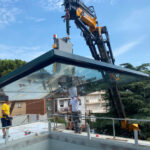In the world of construction, interior design, and window installation, handling heavy glass is a task that demands precision, safety, and the right techniques. Given the fragile and often cumbersome nature of large glass panes, employing proper lifting methods is not just about efficiency—it’s a critical component of workplace safety. This blog post delves into five effective strategies for lifting heavy glass, ensuring that readers are equipped with the knowledge to handle these materials safely and effectively. From manual handling to the use of advanced glazing robots, we’ll explore a variety of methods that cater to different needs and scenarios.
1. Manual Handling

Lifting heavy glass manually requires more than just brute strength; it requires technique. Proper lifting techniques are paramount to prevent injury and ensure the safety of both the workers and the glass itself. Always remember to lift with your legs, not your back, to avoid strain and potential injury. When lifting heavier panes, team lifting is essential. This not only distributes the weight more evenly but also ensures that the glass is kept steady and secure. It’s important to establish firm grips and clear communication among team members to coordinate movements. Additionally, wearing gloves with a good grip can prevent slips, further securing the safety of the material and handlers.
2. Suction Pads
Suction pads, or vacuum cups, are invaluable tools for lifting heavy glass. They work by creating a vacuum seal between the pad and the glass surface, allowing for a secure grip without the risk of damage. Suction pads offer significant advantages in terms of ease of handling and reducing manual labor. However, their effectiveness is contingent on proper placement, clean glass surfaces, and regular maintenance to ensure the vacuum seal remains strong. It’s also important to use the right number and size of suction pads to distribute the weight evenly and maintain control of the material during lifting and moving.
3. Mechanical Lifters
For larger and heavier glass panes, mechanical lifters can be a game-changer. These devices, which include vacuum lifters and hoists, are designed to handle heavy loads with precision and safety. Vacuum lifters, for instance, use suction technology to securely attach to glass panes, allowing for smooth and controlled lifting and placement. When using mechanical lifters, it’s essential to adhere to safety considerations and ensure that all operators have undergone the necessary training. This not only maximizes the efficiency of the lifting process but also minimizes the risk of accidents and injuries.
4. Glazing Robots

Glazing robots, as the ones you can find at cpslift.com, represent the cutting edge of glass handling technology. These automated systems are designed to lift, maneuver, and place heavy glass panes with unparalleled precision and efficiency. The use of glazing robots significantly reduces the physical strain on workers and enhances safety by minimizing human interaction with heavy materials. Various models and features are available in the market, catering to different sizes and types of glass. While the initial investment in glazing robots can be substantial, the benefits in terms of productivity, safety, and quality of installation are undeniable.
5. Collaborative Tools and Equipment
In addition to the methods mentioned above, there are various collaborative tools and equipment designed specifically for heavy glass lifting. These include glass manipulators and assistive devices that work alongside human operators to enhance safety and efficiency. Such tools are particularly useful in situations where manual handling is necessary but can be made safer and more manageable through technological assistance. By integrating these collaborative tools into glass handling tasks, teams can achieve a balance between the control and precision of manual handling and the safety and efficiency of mechanical assistance.
Understanding Ergonomics
Ergonomics plays a pivotal role in the safety and efficiency of handling heavy glass. Proper ergonomic practices ensure that workers maintain comfortable and natural body positions throughout the lifting process, reducing the risk of strain injuries. It’s essential to educate workers on recognizing the signs of ergonomic strain and implementing corrective measures. This might include adjusting the height at which work is performed, using adjustable tables for cutting or assembling it, and ensuring that the work environment is conducive to natural movements and postures. Emphasizing ergonomics not only promotes health and safety but also enhances productivity by minimizing fatigue and discomfort.
Safety Gear and Personal Protective Equipment (PPE)

The use of appropriate safety gear and personal protective equipment (PPE) cannot be overstated when working with heavy glass. Protective gloves, safety glasses or goggles, and steel-toed boots are fundamental to safeguarding against cuts, abrasions, and impact injuries. For tasks that involve cutting or breaking glass, additional protective clothing such as aprons and arm guards may be necessary to protect against shards and splinters. Regular inspection and maintenance of PPE are crucial to ensure its effectiveness. By making PPE a non-negotiable aspect of the glass handling process, workers are better protected against common hazards associated with glass work.
Emergency Preparedness and Response
Being prepared for emergencies is a critical aspect of working safely with heavy glass. This includes having a well-articulated emergency response plan that all team members are familiar with. Training should cover the handling of glass breakage incidents, including the safe cleanup of glass debris and the treatment of cuts or other injuries. Equipping the workplace with first aid kits, emergency contact information, and clear evacuation routes ensures a swift and effective response to any incident. Additionally, regular drills and training sessions help reinforce emergency procedures and keep safety at the forefront of workers’ minds. Through preparedness and proactive measures, the risk of serious injury can be significantly mitigated, creating a safer working environment for everyone involved.
Conclusion
Lifting heavy glass safely and efficiently requires a comprehensive understanding of the right techniques and tools. From manual handling and suction pads to advanced solutions like mechanical lifters and glazing robots, there’s a wide range of methods available to meet the diverse needs of different projects. Moreover, the emergence of collaborative tools and equipment has further expanded the possibilities for safe and efficient glass handling. Regardless of the method chosen, ongoing training and awareness of best practices are crucial to prevent accidents and injuries. By carefully considering the specific requirements of each lifting task and prioritizing safety and efficiency, individuals and teams can ensure successful outcomes in all their glass handling endeavors.







